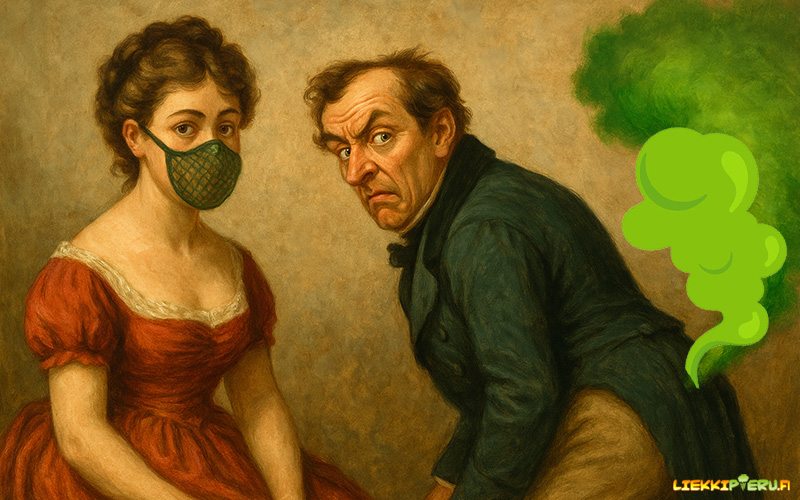
Fart and Vanvera – The Fragrant Secret of 19th-Century Venice
If there was one topic that made the Venetian aristocracy of the 1800s nervous, it was the fart. The mosaics on marble bridges, gilded mirror frames, and masquerade balls—where even moonlight seemed overdressed—could not be disturbed by the rumble of stomach gas. The solution to this aromatic dilemma was the Vanvera, a fragrant device that transformed even the haughtiest of emissions into a lavender-scented salon secret. A poorly timed toot could scare porcelain dogs into the canal and make the Doge´s palace lace flutter like seagulls in a sea breeze. That’s why every self-respecting dandy invested a small fortune into a Vanvera, ensuring their farts remained socially acceptable and didn’t rise as gossip over the lagoon.
The Imperial Protocol of Elegant Flatulence
Venetian etiquette was ruthless. It wasn’t enough to know which end of the oyster to open or which foot starts the dance trio; even the stomach’s sounds, especially the fart, had to follow the key of silence. If the belly cauldron let out its chlorophyll fumes at the wrong time, dinner collapsed like an overloaded gondola plank. No one wanted to go down in history as the Talking Buttock, so a solution was needed—scientific, artistic, and delightfully entertaining: the Vanvera.
Aatu and Amalia´s Aroma Boxes
Countless salons swore by the Vanvera, which came in two main models—much like today’s light and zero sodas, but with more... tangible effects. Any hostess worth her salt ensured the household winds were as precise as the fanfare of an opera´s alto horn. And anyone who boasted they could manage without a Vanvera was looked at like a gondolier trying to row without oars: tragic, but undeniably entertaining to the crowd.
Underwear Vanvera
A flat, palm-sized metal box was slipped inside a corset or into the waistband of wide silk trousers. The box was filled with dried herbs—lavender, rosemary, sage, and a pinch of nutmeg “if the dinner involved cheese”. When nature called, a small vent opened, and the incoming gust tiptoed out like a well-mannered ghost: completely silent and scented like a breeze from the fields of Provence.
Pipe Vanvera
In wealthy palaces, a brass capillary pipe led the airflow to an adjacent room—most often a servant´s corridor. The method mirrored today´s “not in my backyard” mindset: the salon stayed rose-scented, and the only one wrinkling their nose was a kitchen boy on the other side of the wall.
Both versions shared the same noble mission: to cage the sound and release the scent with Chanel-like finesse. If you´re wondering Sound or Smell?, Vanvera chose the diplomatic middle ground.
Roman Roots and Fart Politics
The device didn’t appear in a vacuum. In ancient Rome, convivia feasts offered plenty of wine, poetic odes of praise, and, yes, the fart performed as an unpaid comedian. Emperor Claudius even issued an edict allowing “nature to blow its brass trumpet without shame.” Venice’s counterpart was more refined: the same blast, but muffled, decanted, and herb-marinated. Of course, Roman madness didn´t vanish: Emperor Heliogabalus allegedly hired a flutist to accompany each senator´s fart, and Nero organized contests to find the empire´s most harmonious gas. With such a grandiose flatulence culture flowing into Venice centuries later, it’s no wonder Vanvera was born—silent on the outside but as theatrical within as a Colosseum spectacle.
“Parlare a vanvera” – Hot Air or Hilarity?
Linguists have long debated whether the phrase parlare a vanvera—“to talk nonsense”—originated from this very contraption. The idea is too delicious to dismiss: if the rear produces empty gas, why shouldn´t the mouth do the same? More likely, the phrase has roots in the exaggerated gestures of medieval street performers, but the legend lingers—just like Vanvera’s lavender core.
Vanvera, the Grandmother of Modern Filters
If Instagram had existed in the 1800s, Vanvera would’ve trended under #FilterNo5. It blurred the noise, spotlighted a curated reality, and left an elegant, albeit artificial, aura. The only difference? Today’s filters refine faces—Vanvera refined the region where the sun rarely shines, unless it’s a bright lavender gust day.
Practical Guide from 1823
Before you tune your own Vanvera, review these salon secrets distilled into three-sentence guides from 1823. These circulated as handwritten cards among the elite, teaching how to manage gas without compromising elegance. Follow these, and even today, you can walk like a lavender-scented hero, corset creaking and all.
- Filling: Never use garlic cloves. Once tested, and the priest fainted mid-sermon.
- Placement: If the corset’s too tight, place Vanvera at an angle; straight pipes are overrated.
- Maintenance: Change herbs after every three dinners, or when the salon kittens start sharpening claws on you.
- Emergencies: Suspect a clog? Light a candle under the floorboards. If the scent boomerangs, your brass pipe leads to the wine cellar—or worse, the guest room.
When Etiquette Met Physics
Vanvera was a scientific marvel of its time. Local physicians debated whether the herb filter influenced the “temperament” of flatulence. Some claimed rosemary added a zesty twist, while others swore lavender calmed both the mind and the explosive undercurrent. Sounds silly until you remember modern kombucha buyers trust anything labeled “gut-health.” A pamphlet from the 1820s claimed a proper blend could reduce fart volume by 12 decibels—a precision modern decibel meters envy. Other researchers abandoned the project when the test chamber exploded, showering lavender dust over a palace attic for a week. Meanwhile, today’s humorists argue A woman´s fart is more dangerous than a man´s, or at least more clickable.
The Lingering Legacy of Vanvera
Though the device vanished with the corset boning era, its spirit remains. Modern fart-neutralizing underwear, garage carbon filters, even space station air systems—all trace lineage to Vanvera, albeit clad in tinfoil. Today’s smart textiles promise to neutralize farts, but in truth, they echo Vanvera’s ancient pledge. Every odor mask, charcoal-infused mattress, or deodorized dog coat is a tribute to the lavender trail above Venice’s canals.
Epilogue: What Does the Venetian Scented Fart Teach Us?
Before we leave these lavender breezes behind, let’s reflect on what Vanvera reveals about human nature. 19th-century fart etiquette speaks as much of innovation as it does of endearing embarrassment. Here are the essential lessons of that delightfully absurd era:
- Civilization is a performance: Curtains change, human nature doesn´t.
- Shame drives invention: Muting your Zoom mic is the digital Vanvera.
- Stories outlive tech: Vanvera lives on, even if no device survives.























